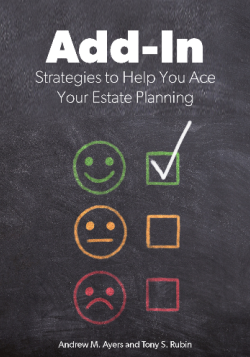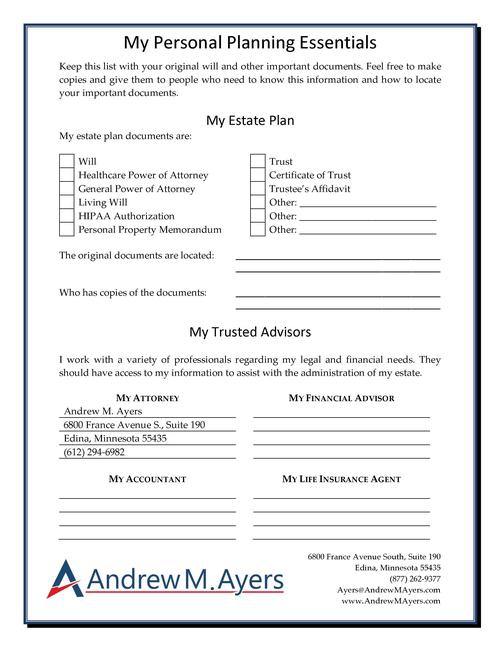 When it comes to estate planning, the goal is to ensure your assets are distributed according to your wishes after you pass away. While many people are familiar with the basic elements of an estate plan, such as a will, trust, and power of attorney, fewer are aware of the importance of a Personal Property Memorandum (PPM). This document can play a crucial role in allocating your personal belongings and provide clarity for your loved ones during a difficult time.
When it comes to estate planning, the goal is to ensure your assets are distributed according to your wishes after you pass away. While many people are familiar with the basic elements of an estate plan, such as a will, trust, and power of attorney, fewer are aware of the importance of a Personal Property Memorandum (PPM). This document can play a crucial role in allocating your personal belongings and provide clarity for your loved ones during a difficult time.
Although it can be a very effective document, PPM's are not recognized in all states. For example, in Minnesota, a PPM is allowed and is legally effective as a part of your estate plan. However, if you're like some of my clients who live in states like Connecticut or New York, those states do not recognize a PPM and therefore you should work with your attorney to make alternate provisions in your estate plan.
What is a Personal Property Memorandum?
A Personal Property Memorandum is a supplemental document to a will or trust that outlines how you wish to distribute your tangible personal property. Tangible personal property includes items like:
- Jewelry
- Furniture
- Artwork
- Clothing
- Electronics
- Other personal belongings that are not classified as real estate or financial assets.
The PPM allows you to specify who should receive these items without having to detail each item in your main will or trust document.
The beauty of a PPM is that it is a flexible and dynamic part of your estate plan. Unlike a will, which can be cumbersome and costly to update, a PPM can be changed easily without requiring formal legal procedures. This flexibility allows you to update the memorandum as often as necessary to reflect changes in your personal property or wishes.
How Does a Personal Property Memorandum Fit into Your Estate Plan?
A PPM is typically referenced in your will or trust, making it an integral part of your estate plan. When properly incorporated, the PPM carries the same legal weight as the will or trust concerning the distribution of the specified personal property. Here’s how it generally works:
- Reference in the Will or Trust: Your will or trust should include a clause that refers to the PPM and states that it is intended to be part of the document. This reference gives the PPM its legal authority.
- List of Personal Property and Beneficiaries: The PPM itself will contain a detailed list of your personal items and the intended beneficiaries for each item.
- Execution and Storage: Like other estate planning documents, a PPM should be signed and dated. It should be stored in a safe place, typically with your will or trust documents, and shared with your executor or trustee.
Why Use a Personal Property Memorandum?
There are several reasons why you might want to include a Personal Property Memorandum in your estate plan:
-
Flexibility: As mentioned earlier, a PPM is much easier to update than a will or trust. If you acquire new items or change your mind about how your belongings should be distributed, you can simply update the PPM without having to go through the legal formalities of amending your will or trust.
-
Clarity and Specificity: A PPM allows you to be very specific about who should receive certain items. This specificity can help prevent disputes among beneficiaries, who might otherwise argue over sentimental or valuable items not explicitly mentioned in the will.
-
Avoiding Probate for Certain Items: Some personal property items might not be worth going through the formal probate process. By including them in a PPM, you can ensure they are distributed according to your wishes without involving the probate court for each item.
-
Cost-Effective: Updating a PPM is typically free or low-cost, especially compared to the potential cost of revising a will or trust through an attorney. This makes it a practical option for managing personal property distribution.
How to Create a Personal Property Memorandum
Creating a PPM is relatively straightforward, but there are a few steps you should follow to ensure it is effective and legally enforceable:
-
Review Your Estate Plan: Before drafting your PPM, review your existing estate planning documents. Make sure your will or trust includes a clause that incorporates the PPM by reference. If it doesn’t, you may need to consult with your attorney to update your will or trust accordingly.
-
List Your Personal Property: Make a detailed list of all the tangible personal property you want to distribute. Be as specific as possible to avoid any ambiguity. For example, instead of just listing “jewelry,” specify “diamond necklace” or “gold bracelet.”
-
Designate Beneficiaries: Next to each item, clearly designate the beneficiary who should receive it. You can include additional details, such as the beneficiary’s full name and relationship to you, to avoid any confusion.
-
Sign and Date the Document: For your PPM to be legally valid, you should sign and date the document. While not always required, it’s a good practice to have your PPM witnessed and notarized, similar to how you would execute a will.
-
Store the PPM with Your Estate Plan: Keep the PPM in a safe place, such as a fireproof safe or a secure file with your attorney, and ensure that your executor or trustee knows where to find it.
-
Review and Update Regularly: Life changes, and so do your possessions and relationships. Review your PPM periodically and update it as needed to reflect any changes in your personal property or your wishes.
Downsides to a PPM
While a PPM is a valuable tool in estate planning, there are some potential downsides to be aware of:
-
Not Legally Recognized in All States: As mentioned above, while many states recognize PPMs, some do not. It’s essential to check with an estate planning attorney in your state to ensure a PPM is a valid part of your estate plan.
-
Contradictions with the Will or Trust: If there is a contradiction between the PPM and your will or trust, the primary document (the will or trust) will usually prevail. Make sure all your documents are consistent with each other.
-
Scope Limitations: A PPM should only be used for tangible personal property. It is not suitable for real estate, financial accounts, or other assets that require more formal transfer procedures.
A Personal Property Memorandum is a practical and flexible tool that can enhance your estate plan by providing clear instructions for the distribution of your tangible personal property. By including a PPM in your estate plan, you can ensure that your personal belongings are distributed according to your wishes, minimize potential disputes among beneficiaries, and maintain flexibility as your circumstances change. If you're considering adding a PPM to your estate plan, consult with an estate planning attorney to ensure it is properly drafted and legally enforceable in your state. This simple yet effective document can provide peace of mind and clarity for both you and your loved ones.
Need Help With Your Minnesota Estate Plan?
Choosing the correct documents for your estate plan is a vital first step, and if you need help deciding if you should use a Personal Property Memorandum, let's schedule a Legal Strategy Session online or by calling my Edina, Minnesota office at (612) 294-6982 or my New York City office at (646) 847-3560. My office will be happy to find a convenient time for us to have a phone call to review the best options and next steps for you to work with an estate planning attorney.





